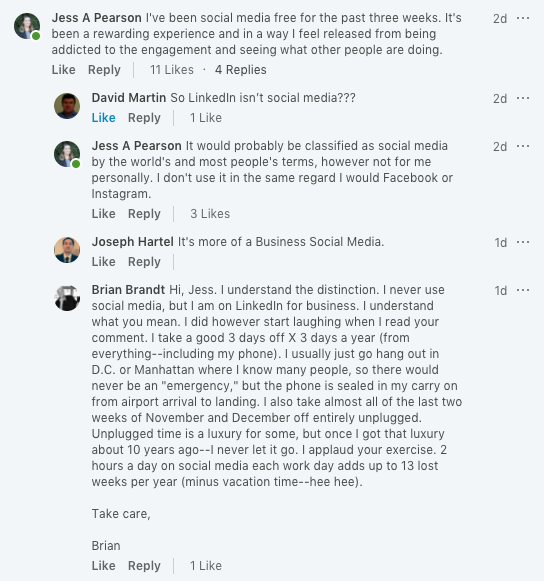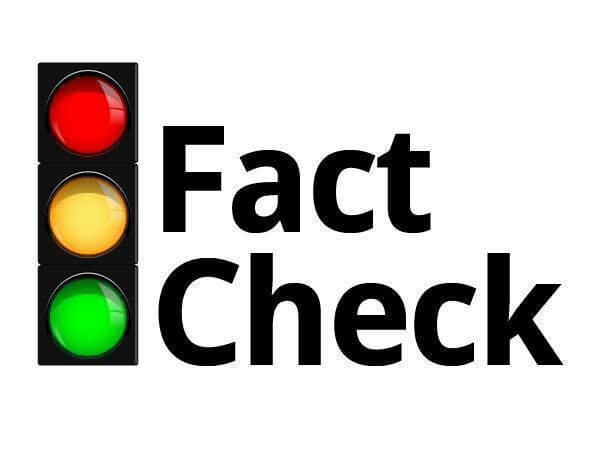Quill is a financial services business with a team of passionate professionals who are committed to working with family businesses, working families and retired families.
Recently I was checking my LinkedIn and came across some content questioning the use of social media. Being 3 weeks (and 2 days – but who’s counting) social media free, I couldn’t help myself but to get involved in the conversation.
However, I soon discovered that my personal definition of social media was different to others.
The conversation went something like this:
*Clarifying what Brian meant: he unplugs for three days, three times a year—nine total unplugged days split in lots of three.
My perception of LinkedIn is truly business based, and I wouldn’t necessarily use it the same way that I would Facebook, or Instagram.
But social media, by the Cambridge Dictionary definition, would one hundred percent include LinkedIn:
Social Media
Forms of media that allow people to communicate and share information using the internet or mobile phones.
This being said, if you include LinkedIn as social media, then you wouldn’t agree that I’ve been ‘social media’ free!
Here are statistics from December 2017 of the Australian usage of social media:
- Facebook – 15,000,000 Monthly Active Australian Users
2. YouTube – 15,000,000 UAVs
3. Instagram – 9,000,000 Monthly Active Australian Users
4. WordPress.com – 5,700,000
5. WhatsApp – 5,000,000 Active Australian Users
6. LinkedIn – 4,200,000 Monthly Active Australian Users approx
7. Snapchat – 4,000,000 DAILY Active Australian Users
8. Tumblr – 3,800,000
9. Twitter – 3,000,000 Monthly Active Australian Users approx
10. Tinder – 3,000,000 Australian users
11. TripAdvisor – 2,800,000
12. WeChat – 2,750,000 Monthly Active Australian Users approxThe perception of social media truly is a powerful thing. Whenever I’m around teenagers, I note that social media to them means keeping in constant communication with friends and peers. Their amount of Instagram followers rank their value.
When I’m around marketers, I take in that social media means business – and it needs to be done religiously. On the other hand, creatives use social media as a means to express themselves, and to drive business.
Social media has created a space for people to express themselves in any way that they want.
Social media is an opportunity.
Ted Rubin, leading Social Marketing Strategist, puts it this way:
“Social marketing is second nature to me. I have always been a networker and connector. Social allows me to take it to the next level and easily create and nurture communities. Always keep in mind that a Network gives you Reach, but a Community gives you Power. In addition, I was always a frustrated author because writing, and communicating via the written word did not come naturally to me. Social allows me to do both in a similar fashion to how I communicate when I talk, and short form publishing is not only acceptable, but preferable.”
How are you utilising social media, and what are your thoughts on the definition and perception? Feel free to get in touch with me in the comments below.
Get yourself organised for the rest 2018
Now, if you’re anything like me, you may have started back at work a little tired, a little sick and one hundred percent ready to go back on holidays. The truth is that it can really take some self-control and self-discipline to get yourself back into work mode for the year.
I thought I would share with you some of my personal tips that have motivated me to get back into the new year; personally, professionally, and practically.
1. Establish routine
After a week or two off, it can be hard to snap back into our carefully crafted routine. If you have travelled away you may have picked up a flu, or you may be struggling to get to bed at a better hour for optimal sleep.
Routine is incredibly important for our body clock, and our brain. It’s the small choices we make in our habits daily that fuel the person we are becoming. Part of my routine is making sure I have my breakfast and lunches prepared for my work week. I am saving time by preparing them in one allocated time, and saving money by not spending during the week on food. This also ensures that I am not swayed by an unhealthy choice.
However, routine is all about balance! Making the choice to only purchase coffee on Mondays and Fridays and aiming to have one lunch per week where I choose to eat out, gives me something to look forward to. On occasion, my co-workers Kellie and Carol-Anne will make me a coffee, which is such a sweet surprise for me! Of course, part of routine also means that I purposefully leave my weekends to be a lot more flexible.
I have other weekly habits and commitments (exercise, meditation, personal training, personal finance monitoring) that enable me to build the blocks of my life around them. Find out what works for you in organising yourself – maybe you need to take a page from Zuckerberg’s book and wear the same outfit everyday, or at least have it planned in advance!
As an INFJ, with a self-confessed need to have my ducks in a row, I have often joked to close friends that I schedule time for spontaneity. Look for the gems, and the space, in your own routine that allow you to enjoy a balanced life.

2. Put boundaries in place
“Boundaries? I’m an adult, do I really need boundaries?” The answer is yes.
Just like routine, our minds and bodies need established healthy boundaries to keep in check. But what does this look like? For me, this meant committing to a month off my personal social media. Of course, working in marketing means that part of my role is to assist the management of our social media accounts. However, I knew that I needed to exercise some control over my thought patterns so that I wasn’t dipping back into my holiday mode by ‘monitoring’ those that are perhaps still on holidays or have different work commitments. It’s important to look back fondly on the holidays, but not enable yourself to get stuck in the same mindset.
Kick that fear of missing out to the curb, and get on with what you have to do.
Assess if anything is prohibiting you from being able to focus on your job, or what you’re doing right now. Whatever boundaries you need to put in place to go in hand with your routine, keep your eyes on the prize.
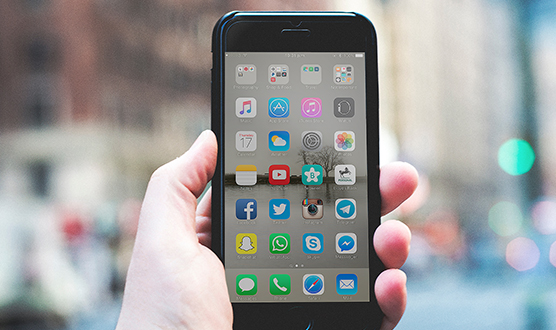
3. Celebrate wins and failures.
Celebrate the ‘small’ wins in your life. Did you get up on time this morning and organize yourself for the day, and arrive at work on time? Learn how to celebrate that, even though it seems like a small task.
However, potentially the hardest thing to do is to accept failure, disconnect your self-worth, and be able to move on and do it better next time.
For Christmas last year, the Marketing Manager gifted me the book “I don’t have time” by Audrey Thomas and Emma Grey. From the first page of the book, I was captivated. Admittedly, still not having finished it, it has already made a huge impact on me.
Following on from a particular lesson in the book, it gives you the opportunity to write down your failures, to release yourself from them. So Fabs, the Marketing Manager, and myself, had a 2018 planning meeting where we detailed our professional failures in the previous year. This list enabled us to plan for this year and know what areas to focus on to do better in.
Maybe you need to change the way that you look at your achievements or failures, and your calendar. Release yourself to enjoy your life – every aspect of it.

4. Set personal goals for the year
Goal setting looks different for everyone, but the most important thing is that you take the time to think about your goals. What does this look like for you? Maybe it looks like writing it down on paper, using a productivity app such as Asana, or keeping a goals board. It might mean informing your close family and friends about these goals, too.
However, this goes further than just 2018. Think big picture. Think 10 years down the track. Where do you envisage your life to be? Where would you like to be, personally?
Track your goals in whatever way suits you. Bullet Diaries are practical and have the ability to personalise every aspect.
Work is a massive priority in each of our lives. However, it can be easy to feel like your head is spinning, if goals in your personal life are not kept up to date. If you want to read more about self-awareness in the workplace, Sheryl Sandberg’s sharing manifesto will enlighten you.
Of course, work goals are incredibly important too. This is where celebrating your wins and failures, and establish team planning from this, is vital.

5. Focus on the good.
There is an amazing quote by Gretchen Rubin, “I wish I could not wish.” We live in a western society that is focused on what we don’t have, materially or otherwise.
Life is about focussing on what you do have, and what you are appreciative for. Family, friends, a roof over your head.
My favourite ways to remind myself to focus on the good:
• Close your eyes for a moment and take a couple of deep breaths in
Feel your body become energised and refreshed with every breath in.
• Do one thing for yourself every day
This could be something simple and small, but making the commitment to prioritise yourself if even just for a moment, makes all of the difference. Think of how you take care of your family, or cherish your friends, and be able to extend that same love and grace to yourself.
• Drink water
Very practical, but drinking the water your body needs is about more than just hydration. Remind yourself how blessed you are to have access to clean to drink water.
Daylight Saving Poll Urgently Needed
This time last year, I wrote a blog about daylight saving which received more likes than any blog I have ever written. That either says something about the quality of previous blogs, or hopefully shows that a lot of people in South East Queensland are passionate about this topic.
The complacency continues…
Unfortunately, twelve months on and Queensland is still in the dark ages despite the Billions in lost revenue to the State each year. So, what will it take to change the minds of the politicians in Queensland? Well, I recently had a chat to our local State member who indicated that whilst she believed most Queenslanders would support daylight saving, the farmers and folk up North would object. Clearly, the State Government prefers to take a low risk, steady as she goes approach which means that they will sit on their hands and nothing will happen.
What are we waiting for? Let’s create more jobs and boost the economy!
Judging from my random poll over the recent Christmas break I would safely say that 70% of South East Queenslanders would support daylight saving if only given the chance to have a vote. So, the big question is how to get the Government or media to take another major poll on the subject? With all the talk about creating jobs, the easiest thing to do to create a boost for our economy would be to run another daylight saving trial. We are about to have hundreds of thousands of overseas visitors come to the Gold Coast for the Commonwealth Games and whilst daylight saving officially ends on 1st April this could be extended till the 15th April in Queensland. Guaranteed to create more jobs and boost the State economy.
In January 2017, and having been 25 years since Queensland did it’s last trial, Brisbane City Council’s Deputy Major Adrian Schrinner believed it was time to give daylight saving a “fresh go”. He created a poll which had a large majority of over 80% of votes leaning towards yes. However, it took it a step further than that and an e-petition was made, which was then tabled at the end of February 2017 but most importantly had over 23,000 signatures. In December, Gold Coast Mayor Tom Tate spoke out about daylight saving time in Queensland stating he is for it because of the economic growth. So, what’s happening now?
How can we motivate other local politicians?
I’m looking for other suggestions as to how we can motivate the local politicians into action and get something happening. Maybe the local Government politicians on the Gold Coast and Brisbane have a bit more fire in the belly and are willing to listen to the majority of their constituents? After all, the old argument around cows, curtains and kids just does not stack up anymore and unless someone can explain how in NSW, Victoria and South Australia all those things work just fine then the only argument left for the minority of Queenslanders who object to daylight saving is the reluctance to change habits. This, like any change, will be well forgotten after two to three weeks and jobs and the economy will be the big winners in Queensland. #GOdaylightsavingsforQLD
We have all heard the saying “Cash is King”. This phrase is often used to describe the amount of notes and coins that we carry in our wallets. However, how does this phrase now sit in our world with the increasing reliance on new payment technologies such as “Tap & Go” and “Apple Pay” to make cashless payments?
In recent times, we have seen the growth and success of a number of business models that only deal in “cashless” payment systems. A great example of how successful a business can be using the “cashless” business model is evidenced by the success of “Uber”. In 2016 Uber generated revenue of 6.5 billion (USD). Who would have thought that hiring an on-demand driver could be done at the press of a button on a smart phone device?
How has the importance of cash declined with the push towards a cashless society and how far away is Australia from being a truly “cashless” economy?
Australian consumers appear to be embracing the move towards a cashless society. The use of smart phones and tablets to enable transactions has resulted in around 82% of Australian payments being made using non-cash dollars. It is estimated that more than three out of four face-to-face transactions are tap-and-go.
This year the Reserve Bank plans to launch technology to facilitate the move towards enabling more cashless transactions. The New Platform System (NPP) will allow money to be transferred almost instantaneously, even when the payer and payee are with different banks.
The whole process of paying for services will become simpler and the transactions will be based on an email address or phone number.
The debate continues about Australia’s end date towards achieving the end goal of being cashless. Some commentators have touted that we may see a cashless society sometime after 2020.
What lessons can be learned from this?
Although “Uber” is often used to promote the success of the cashless business model it is interesting to note that they have not always strictly adhered to their cashless business model. One example of Uber deviating from their cashless business model is in India, where Uber introduced a country-specific initiative to accept cash. This initiative was driven partly by India’s banking regulations but also by understanding the cash economy in that country. Across all of India the cash method is the preferred method of payment by users and drivers. Uber’s understanding of the economic landscape in India lead them to adjusting their cashless business model.
How does this apply to you?
All businesses need to be flexible nowadays. It is important to look at the impact of how a cashless economy would impact on profitability and ultimately survivability.
- Does your business have the technology to handle cashless payments?
- Cash is still an important draw card for consumers around the world – How is your business placed to handle this?
- Most customers appear to adapt to cashless payment platforms but it’s important to educate them about the cashless platforms available within your business.
Main Benefits for Small businesses:
- Time saving in not having to handle cash and making physical deposits at banks; and
- The reduced risk of not having to keep cash on business premises.
How does this apply to your customers?
- The key benefits for consumers is the pure convenience of using these new payment platforms;
- No credit card fees for using a credit card to make purchases; and
- The main concerns for consumers is centred around privacy and fraud risk. Transaction history can be tracked in a cashless payments system.
How will this benefit the Australian Government?
The major advantage for governments operating in a cashless economy is the significantly reduced risk of tax evasion.
Only time will tell how successful the push towards a cashless economy will be in Australia. Will the concept of carrying cash be a dim memory of the past?
Sometimes you need to take the risk.
Recently, I had the opportunity to head to New Zealand for a holiday. It was definitely a holiday full of high adrenaline adventures. The ultimate experience for me was jumping from a canyon wall and free falling 60 metres down a rocky cliff face, to then swing 200m above a river. Sounds scary, doesn’t it?
I can tell you, during those few seconds when I was falling, it was incredibly scary. I was screaming the entire time, then as I reached the swing above the river I realised I had survived, and began giggling with joy!
Suddenly, after the major shock and thrill of the experience was gone, I could take in the birds’ eye view. The feeling took my breath away… so much so that I did it again! And the next time, I was strapped to a chair and fell backwards. It was exhilarating, and like nothing I had ever experienced in my life.
Do the research.
Before the trip, during the planning stage, I had researched the most thrilling jumps you could do in New Zealand. I researched the equipment and safety measures, the costs involved, history of the locations and even read reviews from previous customers about their experiences. Taking all this information into consideration, I then compiled my wish list for adventure.
However, if I hadn’t prepared myself to understand how the jump would work, how the swing operates, and the ins and outs of the entire jump, there is no way I would have enjoyed the experience as much as I did. Being able to understand everything and trust the people that would be operating the jump was very important to me as it meant I could relax into the process.

Here’s the photo evidence of me jumping into the canyon. See? I really did do it.
Doing the research meant that I was able to make the right choice in who to partner with to help me take the risk – and have the best outcome.
Whether it be jumping off a canyon, or taking a risk for your business, there can be many rewards and benefits. It is important to identify and evaluate potential risks, and of course to seek professional advice to develop a detailed plan before you take the leap of faith.
As in life, in business it is necessary to take calculated risks to uncover new possibilities, new markets, new directions and further success. And sometimes it’s about taking that risk to fulfil that business passion or dream you have.
Remember, today is a new day and a new opportunity for you to take ‘harness’ of your professional or business goals. All the best with your ‘jump’… Just as I did in New Zealand!
How do we balance work, fitness and family?
Wait, hear me out… it can be done!
As parents, we do an amazing job of taking care of our partner and children, but often it’s all too easy to push our own needs aside.
I often get the question “How do you do it all?” So I decided to share what works for me, and how I find my balance whilst caring for a husband (otherwise referred to as my additional child!), children, doing a job I enjoy, and prioritising my health and fitness. I’m sure I don’t always get it right and every family balance is different. There is definitely no right or wrong, but just figuring out what works for each family!
One exception is I don’t think this applies to mummies in the first year of motherhood, between feeding, changing, washing, fighting for snippets of necessary sleep and easing back into the workforce your plate is completely full. Well done if you manage to sneak in some workouts!
Start small
If you start out with small goals and make a realistic plan, balance can be so much more achievable. For example, if you decide that your short term goal is to improve your fitness, start out 2 to 3 days a week with small 20 minute fitness goals, maybe a walk during lunch and then increase the frequency and intensity over the coming weeks.
We make our own time
I often find myself wishing I could add a few more hours onto my day. Sometimes 24 hours just isn’t enough to fulfil my parental role, working role, and to be able to stick to a fitness plan. I decided a 4am start (and with a 2-year-old early riser and periodic night waker) gave me an hour or two up my sleeve before the morning chaos.
As a working mum, I used to struggle with a nagging guilt every time I did something for myself. I couldn’t ignore the nagging voice in my head, telling me I was selfish! I make it a priority to remind myself that making regular activity choices in the household will normalise it for my sons, as they grow into adulthood. It took me a while to realise that taking time to care for myself is actually the opposite of selfish.
Prioritise the things that are important to you
Making sure you make time for the tasks or things that are important to you is so valuable in work-life and fitness balance.
Prioritising working out has really helped me stay healthier and energised and given me more quality time with my family. On occasion, I have found that my husband and three sons choose to join me for a 5km run on Saturday mornings (although they don’t always thank me for it!).
Is there such a thing?
This year it seems that the flu virus has been worse than ever and staff absenteeism is on the rise. Every year hundreds of millions of dollars are lost by Australian companies as a result of the loss of productivity due to sickness and illness. According to an article on the Austratlian Financial Review, national health studies showed the flu alone accounted for about 10 per cent of all workplace absenteeism costing more than $2 billion a year.
This year, we have seen an additional 70,000+ workers off sick, costing businesses $30 million per day.
This is not unique to Australia, business and companies throughout the world are looking for ways to reduce illness and foster a healthier and more productive workplace.
The benefit of having healthy and active employees
Research by the University of Queensland suggests that people who exercise regularly experience better physical health, prone to less illness and experience a positive effect on their mental health. In a time when stress and depression is on the increase, crucial for employers to look for ways that can increase employee physical activity, boost confidence and encourage an overall positive outlook to life.
The return on investment from improved mental health alone can be as high as 15X with smaller organisations benefiting more than larger organisations. Healthier employees suffered lower risks of long term illnesses like heart failure, cancer and diabetes and displayed improved morale, reduced absenteeism and lower turnover rates.
What we are doing? (And you can too!)
Some larger organisations like Apple, Microsoft and Google spend millions every year on programs to encourage a healthier lifestyle for their employees. Gym membership, massage, healthy snacks, flu shots and access to wellness centres are just some of the benefits provided to their employees. Of course, most smaller companies don’t have the budget of these global giants. However, it is not difficult to make a start and build from there.
Employees need to be encouraged not coerced into making changes. We recently replaced the sweet biscuits in our office with fresh fruit, introduced free flu shots and are just about to launch a 10-week fitness challenge which has at its core a healthy diet and exercise program. There is both a fun and serious side to the program which offers team building activities as well as the opportunity to have a full body scan and understand more about your body, healthy foods and nutrition.
Everyone wins from this positive initiative. I encourage you to consider this for your business.
You may think that if you don’t run a delivery business and your employees aren’t truck drivers, that as an employer you have no duty to check up on the driving of your staff. Unless they spend long hours driving, then is it really necessary? The answer is yes.
All employers should have a policy in place regarding road safety, if members of staff ever have to drive during their work. This includes driving to other sites, driving to meetings or to visit customers or clients.
FACT: It is estimated that a third of all road traffic accidents involve somebody who is at work at the time.
What can I do as an employer?
Now that you realise you do need to think about driver safety, here are some ways to make employees safer on the road.
Implement a policy
The first thing to do is to let staff know that when they are driving, they are still at work, and their safety is in your hands. You will probably need to write a driving at work policy for employees using their own vehicles. Make sure it is accessible to all staff and includes the key points for employees:
- If using your own vehicle for work purposes, it must be in a roadworthy condition
- Staff must have a valid driving licence
- Staff must have adequate insurance – employers can ask to see this annually
- Staff should ensure they are fit to drive. If they feel unwell or have recently changed their medication they must inform a manager
Other measures
Employers can take other steps to keep staff safe where driving is concerned.
For example, look at how many journeys employees are making in work hours – can these be reduced in any way?
Are face to face meetings essential, or can video conferencing be used instead? In certain cases, the particular job or service requires face to face contact, but for other business meetings there is usually an alternative. If it doesn’t compromise the customer experience, this might be a good one to look at.
Next, think about how local the journey is and is driving really necessary? Could you suggest your employees walk or catch the train to the next client meeting?
Help shape change
When all we seem to hear about on the news is road accidents, we should all help reduce this as much as possible and remember that change can start at work. By using the tips above as a starting point, employers can play their part.
We all know that sending internal emails is standard practice for team communications.
It is one way you can be productive within your business as it’s quick, efficient and everybody works with email.
However, workplace emails can also hinder team productivity. When used incorrectly, internal communication can become saturated and cluttered. Between emails from clients and action items from meetings, it can take hours just to sort through the junk to get to the important stuff.
How to combat clutter of internal email communication
Simple. We all know it, but don’t always do it – use a prefix and suffix in the subject line.
Here’s what we mean by adding it into the subject line:
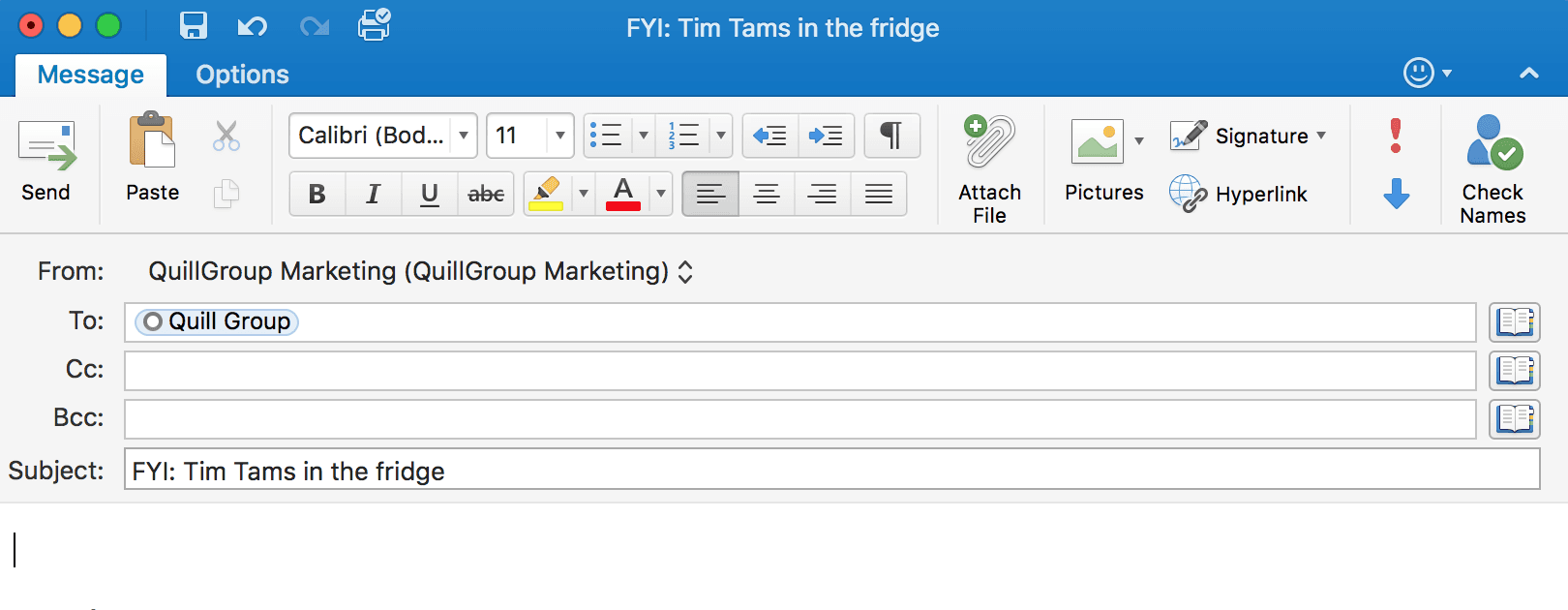
Just by using a prefix and/or suffix in the subject line of your email, you can reduce the decluttering time for you and the team. This saves you opening the email because the objective is already in the subject line or you can make a split-second judgement to continue working on a job that requires full attention, removing the probability of being interrupted with an incoming email.
Refocusing your attention back to the job at hand takes time, especially when it is a complex project with multiple layers. Regardless if it takes 2-5 minutes or 30 minutes to refocus, it is wasted time. So the aim is to try and reduce or eliminate this wasted time.
Common prefixes and suffixes
Here are some of the common prefixes and suffixes used:
FYI (For Your Information)
- The email is “For Your Information” only and no reply is needed
- It can also be used when you want another team member to be informed of a conversation or email thread
For Example:
“FYI: Tim Tams in the fridge. Help yourself!”
“FYI: Bianca is not in today. She is feeling ill”
TO ACTION
- It tells the recipient that the email needs to be actioned or answered
For Example:
“TO ACTION: Nicol Group 2016 Service Package Agreement”
URGENT
- Use this prefix when urgent attention is required or the message is time sensitive
For Example:
“URGENT: Nicol Group 2016 Financial and Income Tax Return”
“URGENT: Please lodge Kevin Nicol 2016 Income Tax Return”
EOM (End of Message)
- This is an efficient way of sending short messages to colleagues or the team. The message of the email is in the subject line.
For Example:
“Kevin Nicol is here for your meeting. EOM”
“Talk to you first thing in the morning. EOM”
Extra tips
TIP 1: Using capital letters when using the above prefixes and suffixes is the best way to get the recipient’s attention.
TIP 2: The combination of prefix and suffix is also another way of improving productivity: “URGENT: Quick meeting in the lunchroom in 5 minutes. EOM”
TIP 3: Having these prefixes and suffixes in internal emails prompts the user to prioritise emails such as:
1st : URGENT
2nd: TO ACTION
3rd: FYI
Prefixes as “tags”
You can also use these prefixes to easily identify which emails you haven’t actioned by skimming through your emails at the end of the day.
Having these tags in the subject lines is handy and you can set a rule in your Microsoft Outlook that if “FYI” appears in the subject, it will automatically move the email to a Reading Folder where you can read at the end of the day or in your break.
This is adopting similar principles that are used in the Zero Inbox theory.
One of the major challenges that all businesses face at one point or another is how to deliver information and ideas to and from staff through meetings. Sometimes it can feel like a constant battle and after every meeting you leave feeling either exhausted or that nothing was really achieved. And the reality is, sometimes, you just want to, well, get on with the job.
Over the 17 years, Quill has grown to a team of 60+ and through that growth, we have continually focussed on optimising our team meetings.
From our experience, here are 6 ways to get the most out of your team meetings.
1. Collaborate on developing the objectives

- Begin the meeting with the end in mind and determine what you want to get out of the meeting.
- Ask everyone to make a contribution. Start with writing down one objective from each person in the meeting. Whether they are playing a big or small role in the meeting. This will help you structure your meetings and figure out if a person actually needs to be in the meeting. It also gives everyone a sense of responsibility towards the content of the meeting which will definitely help with participation.
2. Have an agenda

- Once you have your objectives, you can start to organise the structure of the meeting. Group similar objectives together and section the meeting. Allocate a set time for each section and a person to champion that section.
- Send out the agenda a day or two prior to the meeting so everyone can have enough time to prepare.
- Don’t just set it and forget it. Continually update the agenda template to suit your strategic goals. It should evolve throughout the year.
3. Keep a consistent schedule
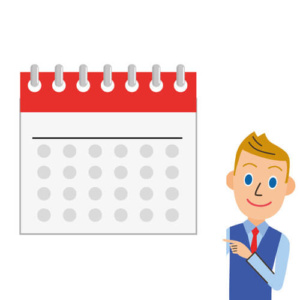
- Repetition is a good thing when it comes to meeting schedules. Not only is it easier to manage, it allows the team to better prepare. They know when it is each month and they can allocate time to prepare each month.
- Don’t use excel to manage your schedule. This is a common mistake that ends up creating no shows for the meeting. Use something that is used daily in the workplace like your project management software or simply your email calendar.
- Make sure you assign someone to champion the scheduling of the meeting.
4. Stay on time

- You should assign a time keeper to track the meeting. By focusing on time, the team will be able to give priority on important topics.
- Start on time! Don’t wait for late comers. It becomes habit to wait for the stragglers to turn up to a meeting. If you continue to wait for them each meeting, you will create a culture of coming late to meetings. Plus, those who do come on time will start to lose interest in keeping that good habit up.
5. Engage Everyone

- Ensure that each participant in the meeting gets a chance to speak about their objective or topic. Even if they don’t have anything to add, it is always good to ask. Simply by asking each person around the table for their thoughts or if they would like to add anything else will motivate your team members to be active in the conversation.
- Remember, meetings are a good time for discussion. Especially when it is with people who are hard to reach or get a response out of. Just keep that in mind.
- Reduce data sharing and keep the conversation going. Sometimes we get lost in the Big Data sharing that we forget to talk about what needs to be done. Leave data sharing for outside meetings.
- Mix up the roles. Have someone different chair the meeting each time, change up the person responsible for noting down any action items to help you track progress in each meeting or allocate a new time tracker each time.
6. Park off topic discussions

- Sometimes a meeting can get off topic and someone can start to ramble about things that should really be discussed at another time. This is where the chair of the meeting needs to take ownership.
- When this happens, the chair should round off the conversation, park it and assign an action item for key stakeholders to discuss it further offline.
Bonus Tips:
- Try to have a stand-up meeting or meeting in a different setting instead of the boardroom. This will help keep the meeting fresh.
- Try to have a paperless and no technology meeting. Once in a while make the meeting informal. No note taking. No technology. Just people and good discussion.
When done right, meetings are a valuable and productive way to get things done in a business.

